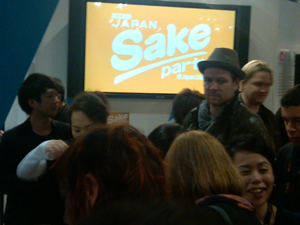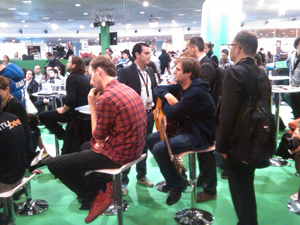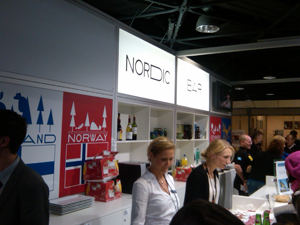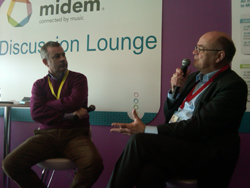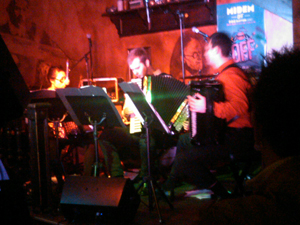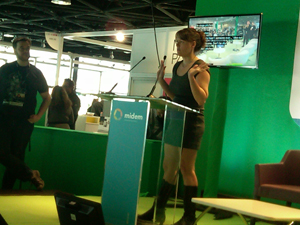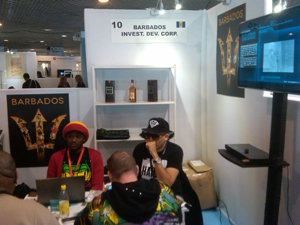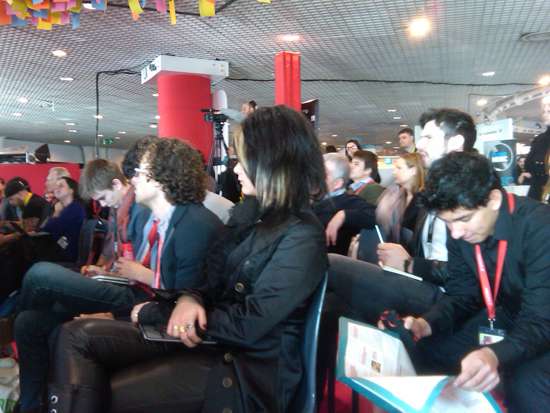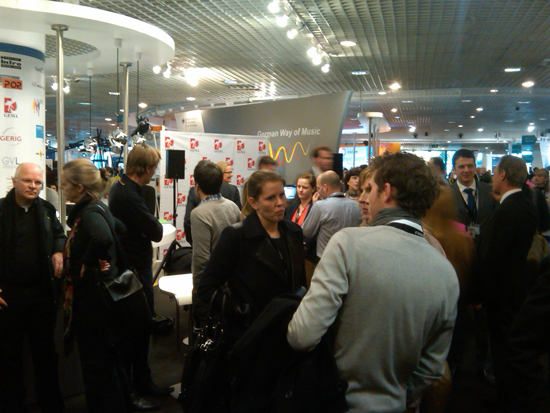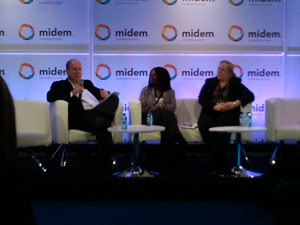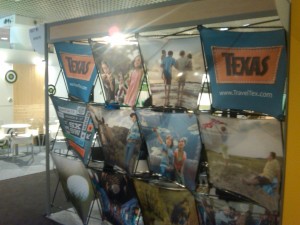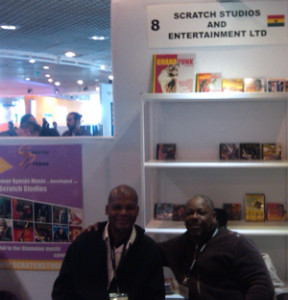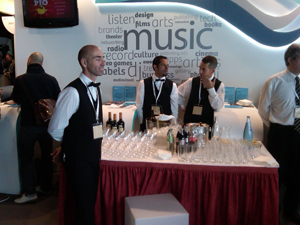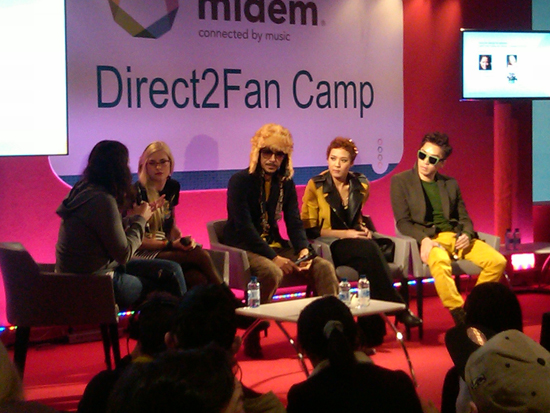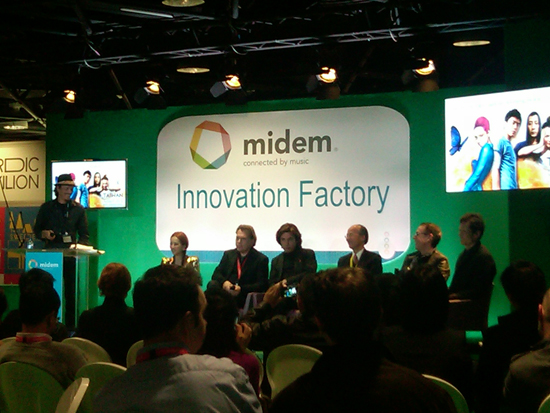This year for the very first time, MIDEM hosted its own music festival featuring a wide range of bands for three nights in a row, in essence morphing into something of a European SXSW. But they are still competing with a longstanding MIDEM tradition: concurrent showcases in local Cannes clubs presented by the various countries in attendance here and which continue to attract large audiences. While Singapore deserves acknowledgement for their auspicious debut showcase, which has already been described herein, a special mention must also be made about the 2012 showcases presented by Canada, which seemed to dwarf those of any other country this year. Canadian bands played to fire hazard-sized crowds for three nights in a row at Morrison’s Irish Pub. I considered attending MIDEM’s own event each of the nights, but after needing to satiate my curiosity about the showcase presented by the performing rights society-averse web portal Jamendo on Saturday and checking out Singapore on Sunday, I felt obliged to check out bands from my northern neighbor.

Toronto-based singer-songwriter Emma-Lee brought a little country to the South of France.
I caught most of the set of an alt country-tinged Toronto-based band led by singer-songwriter Emma-Lee which completely delighted the international audience. Next came Alyssa Reid, whose music seemed a bit too mainstream for me to stay completely focused amidst the din. But I should try again at some point; I’ve long believed that personal taste can be a barrier to experiencing music, and I know all too well that a loud, overpopulated bar is not the ideal place to hear something I haven’t heard before. However, the evening’s concluding act, the Hamilton-based power duo P.S. I Love You, seemed capable of grabbing anyone’s attention in any venue. Their set was a relentless series of extreme electric guitar distortion, uninhibited caterwauling (the guitarist doubled as the band’s vocalist), and pulverizing drumming—I loved it.

The Kingston-based PS I Love You skronked out Morrison’s Pub while the ghost of James Joyce (painted on the wall behind them) connected them to the experimental tradition.
However, I’m not sure—just as I wasn’t in the case of the Singaporian showcase on Sunday night—if there was anything that belied a specific national identity in the music played by any of these Canadians on Monday night. I’ve certainly heard groups based due south of the Great Lakes that sounded similar to the three Canadian acts I checked out. Of course, the internet has even further accelerated the erosion of regional musical differences that had already begun to deteriorate with the advent of recorded sound, radio, and television during the 20th century. In the 21st century, we are moving more and more toward global music identities, and indeed such music has been the ideal soundtrack to compliment the numerous discussions here on Monday and Tuesday about an emerging single global market for music.
Early on Monday morning, the CEOs of the German and Swedish performing rights societies, Harald Heker of GEMA and Kenth Muldin of STIM, participated in a panel about the future of collective rights management in the European Union moderated by Musikwoche‘s Editor-in-Chief Mandfred Gillig-Degrave, and which also included Swedish composer Alfons Karabuda and two politicians, German Bundestag member Ansgar Heveling and Kerstin Jorna, the deputy head of cabinet for European Commissioner Michel Barnier in Belgium. Heker spoke to the difficulties in harmonizing licensing agreements among the 27 E.U. member countries, but acknowledged that it was a necessity in the current marketplace. Muldin added that music and audiovisual work ultimately have no borders. Heveling went further saying, “The time is gone for collection laws to be based on national legislation.” But everyone agreed that there needed to be rules in order to ensure fair competition. While the internet has certainly created a marketplace that is no longer circumscribed by geopolitical realities, it was interesting to learn that, according to Muldin, 60% of the total world income derived from the usage of creative work comes from Europe. Whatever collaborative initiatives that the performing rights societies will strive toward in the future, Karabuda urged everyone to secure a place for composers who operate at the edges of the marketplace, otherwise there is no guarantee of musical diversity.
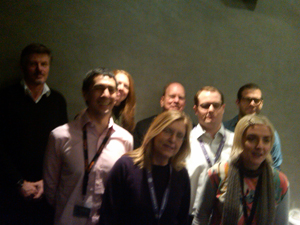
Participants in the discussions about establishing an Indie Music Manifesto: (L to R, back row) Jonas Sjostrom, Portia Sabin, Rich Benglott, Nick O’Byrne; (middle row) Mark Chung, Charlie Phillips; (front row) Alison Wenham, Helen Smith
Sustaining musical diversity was also a key agenda item for a group of representatives of independent music companies from around the world who met to establish a Global Indie Manifesto. “Plurality is the best driver of creativity,” is how UK-based Alison Wenham, chairman of the Worldwide Independent Network (WIN), put it. Wenham, who led the discussion, also pointed out that 80% of new music releases are on independent labels and that independents employ 80% of the people who work in the music sector. She spoke passionately about the need for the independent sector to reframe the copyright argument, which has become a debate between large entertainment companies and the now even larger technology industry. As she put it, “It is people who make music, so it is people’s rights that have been hijacked in the debate about copyright.” Kill Rock Stars’ Portia Sabin, whose business card gives her official job title as “Label Dude,” didn’t mince words when describing Google and other powerful technology players’ claims that the music industry is not in step with the direction music has gone in, “We’ve heard the music industry doesn’t get it mostly from companies whose business models don’t include paying for music.”
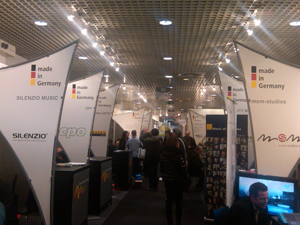
A small portion of the German area of the MIDEM Exhibition Hall.
After that discussion, I was hoping to hear a panel about artists rights but the session was exclusively in French and this time there were no headphones offering instantaneous translation. I barely understand all the ramifications of these discussions when they are in English, so I wandered back to the exhibition hall. The exhibition booths in the halls still clearly show the disparity between various countries’ music industries, despite all the talk about our moving closer and closer toward a single global music economy. Germany, just as they had last year, had the largest presence of any country at MIDEM, even bigger than France, the country which hosts this event. But others, including Iran and Chile and even smaller countries like Macedonia and Cyprus, want to be part of the action, so they find a way to be here. But this year there was not a single exhibition booth from the entire continent of Africa. Will geographical diversity be sustainable as we move further into a global marketplace? And if it isn’t, who will be calling the shots?
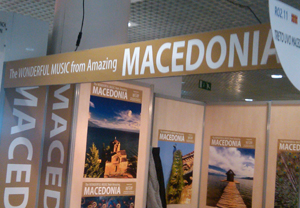
The Macedonian music booth at MIDEM
The largest auditorium at the Palais de Conferences was given over to a series of technology-themed talks called Visionary Monday that occurred through the entire day. Each talk rushed by at warp speed, some lasting only 10 minutes. I caught about an hour’s worth of them before getting a little bit car sick from the information overflow. In a mere ten minutes, UK-based music analyst Mark Mulligan (who blogs at musicindustryblog.wordpress.com) described a future based on fan-fuelled creativity and urged us that “music needs to be free of the stasis of formats.” Will Sansom, a writer and consultant for the UK-based Contagious Communications, described Singapore’s StarHub musical fitting rooms where people try on clothing to a specific soundtrack that is targeted to them based on what they are trying on. The folks in the tryout room are then solicited to by the music via proximity SMS text messages and there has been a staggeringly high 84% click-through rate. Christoph Bornschein demonstrated his midemlab award-winning Vodafone app Mein Tweet als Lied (#tweetlied) which showed how fast Vodafone’s phone lines are through tweets that were turned into a song by a band in 15 minutes. After a short break, Dan Rose, Facebook’s VP for Partnerships, talked about how social media has the ability to finally make “music online the way it was meant to be.” He described the sharing of songs online as analogous to giving mixtapes to friends of songs recorded off the radio (something he did 20 years ago), only now it is “at scale.” In the last four months, according to him, 5 billion songs were shared across 50 countries via Facebook.
This morning’s talks began with a heated discussion about licensing “the cloud” in which participating panelists could not agree on exactly what the cloud is. Mitch Rubin, the head of music publishing business affairs for Nokia, stated that the cloud “is a marketing term; it is not legally defined.” But Richard Conlon, the senior vice president for corporate strategy, communications and new media at BMI, warned that it was erroneous to describe the cloud as merely a locker where you can store things:
If its just storage then it’s not commercial, but that’s a bunch of baloney and we have to be very vigilant about that. […] There is not a whole lot of love for the creative community in Silicon Valley.
One of the problems, as AMV Talpa GmbH’s Managing Director Jens-Markus Wegener pointed out, is that there is no way to stop illegal content from being on cloud-based services. But he was also clear that he does not want to impede progress: “Nobody is hindering good business models. If the model only works if you don’t pay for all the services [e.g. the music], then it’s not a good business model.” SACEM’s Thierry Desurmont hit the nail on the head of what the chief problem is with the new paradigms for the music business, “It’s not easy to obtain fair remuneration from the service providers.”
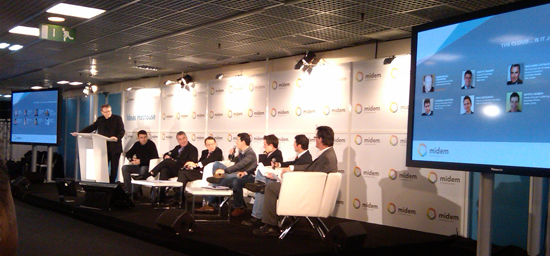
Participants in a highly-charged MIDEM panel The Cloud – Is it Just a Licensing Issue? (L to R): UK-based journalist Emmanuel Legrand (moderator); Rdio’s Head of Strategic Partnerships Scott Bagby (UK); Richard Conlon, BMI’s SVP, Corporate Strategy, Communications and New Media (USA); Thierry Desurmont, SACEM’s VP for Legal and International Affairs (France); Charlie Lexton, Head of Business Affairs and Legal Councel for Merlin (UK); PRS for Music’s Director of Online Licensing Ben McEwan (UK); Nokia’s Head of Music Publishing Business Affairs Mitch Rubin; and Jens-Makus Wegener, Managing Director of AMV Talpa GmbH (Germany).
The final discussion I attended on Tuesday was a lively debate about the Global Repertoire Database that pitted various publishers and managers from performing rights societies against representatives from Omniphone and Google. This was much more engaging than the talk I attended on this same subject last year in which the voices of individual artists or their representatives seemed conspicuously absent. The publishers now seem completely behind the idea of establishing this single database which would have detailed information on all licensable music in order to be a one-stop resource for everyone. However, Ralph Peer II, chairman and CEO of peermusic, who suggested that “we need to treat GRD as a Wiki-type project” also stressed that “it must have the cooperation from all sectors in order to be effective.” Sami Valkonen, who is the head of international music licensing for Google, bemoaned how long it has taken to establish a Global Music Database:
These talks started in 2008. It’s now 2012. Talking about this at MIDEM is like a carousel. If we have the data there’s a way to make this work. […]Google holds the view that the GRD is a public good. We should not be focused on who owns it; it should not be proprietary. […] There are people here who might not like this, but it is a fact that we are moving toward a global licensing system.
Jane Dyball from Warner/Chappell gave some details about an even more all-encompassing database than the GRD called the International Music Registry (IMR) that deals with all recorded performances (audio and video) as well as compositions, which is all that GRD is concerned with. Karen Buse, from PRS for Music in the UK, suggested that the next step should be a database for all audiovisual work. During the question and answer period, someone claimed that smaller independent publishers might see a global database as a threat, since it could make them less competitive in a global market. But according to Jez Bell, director of licensing for Omniphone, “This levels the playing field for smaller publishers.”
Indeed it still could be a brave new world, but now I have to brave the real world. It’s pouring rain in Cannes today, and rumor has it that it will turn to snow and flights will be cancelled. I am still planning to return to New York City tomorrow, but I might be stuck here. The all-powerful internet has yet to feature a viable means of teleportation.

